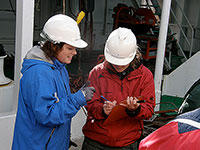KRISTIN FLESLAND

Hovedinnhold
MEET KRISTIN FLESLAND
text and photos by Courtney Flanagan
Kristin Fresland, 26, is studying for her Master's Degree from the University of Bergen. Her topic is Magmatic Petrology, in particular the hydrothermal and volcanic history of the sediment from the Mohns Ridge, found close to the Jan Mayen vent field discovered in 2005. Kristin will analyze volcanic glass found in the sediment for Major, Trace, and Rare Earth elements. On this cruise however, she is not specifically working on her own research. Instead she has a dual function. She is helping Tamara Baumberger collect core samples for her PhD research, and is also working on analyzing the pore water for the Centre. Work on her own thesis will have to wait until she returns to Bergen to continue investigating the sediment obtained from the 2005 research cruise.
The daughter of an English teacher and an accountant, Kristin herself has always been interested in nature. She ended up in geology through a gradual process which sadly, she says, is less possible for current students as universities in Norway now require students to select their major field at the beginning of their studies. Kristin however was able to begin her focus more generally in the sciences, and then to pin down her major area of interest as she continued her studies. She started with math (boring!), then went to physics (better), geophysics (better still) and finally in her fourth semester, geology (Eureka!).
Kristin is still not sure where her career is heading. She has very much enjoyed the research cruise work, but is unsure if she will stay as a researcher or move into the commercial working world. If she does the latter, it would probably be in the oil industry. Having a four year old son certainly complicates her choices to some degree. She is also torn between the extreme ups and downs of life as a researcher, and what seems to be the rather boring repetition of life in industry.
Whether she continues after her current degree into a PhD program or not, she would like to take some time after getting her MA for some "volcanic" travel. She'd like to go to Tenerife, a volcanic island in the Canary Islands, to see Mount Teide, a volcano that remains somewhat active. She would also like to see Vesuvius, also still active and of course historically important because of its destruction of Pompeii.
As has been true with all of our interviews with the scientists on this ship, Kristin added to our knowledge bank. We teachers came into this interview, one of our last, thinking that after two weeks we now knew enough on the subjects of research on the ship that we would have fewer questions and perhaps hear less new information. But of course we were totally wrong! Kristin gave us a very nice simple introduction to some basic geology. For example she explained that petrology (the study of rocks) involved the study of three types of rocks: sedimentary, metamorphic, and igneous On this ship, the rocks of interest are primarily igneous rocks, both intrusive (ones that originally crystallized from magna below the surface) and extrusive (rocks formed after the magna has reached the surface).
Kristin is a quiet person, but one with a fire in her eyes who clearly is excited by her subject. She told us in the interview that she had been first inspired in junior high by a teacher of math and science (news that we teachers were glad to hear!) She certainly was able to pass that spark of interest on to us! I found myself spending time on Wikipedia doing some follow-up reading just for fun on the topics she presented. The interview with Kristin was yet another great short insight into science!
Kirstin Flesland (norsk)
Masterstudent ved Institutt for geovitenskap, Universitetet i Bergen
Noen av studentene ved Institutt for Geovitenskap er heldige og får være med på tokt. For Kristin er dette faktisk andre gangen hun er med. I fjor samlet hun data til masteroppgaven sin, i år hjelper hun Tamara med kjemiske analyser av porevann samt gjør analyser av vann fra varme kilder for Senter for geobiologi.
Kristin er oppvokst på Osterøy, og da hun gikk på ungdomsskolen hadde hun en inspirerende lærer som medvirket til at hun ble interessert i realfag. På videregående skole valgte hun fordypning i realfag, og da hun begynte bachelorstudiene sine startet hun med matematikk og fysikk, men det var først da hun i fjerde semester kom til geologi at hun var sikker på hva hun ville fordype seg i. Kristin har en sønn som er fire år, og hun hadde ett års pause i studiene da han ble født. Med barnehageplass og sans for å utnytte arbeidstiden effektivt har Kristin, som mange andre studenter, kombinert det å være mor med å være student.
Kristin har arbeidet med en masteroppgave innenfor et område av geologien som kalles magmatisk petrologi. Magmatisk betyr at hun har arbeidet med bergarter som er dannet av magma og altså har vulkansk opprinnelse. Petro betyr stein. Og Kristin har virkelig mye kunnskap om stein. Det fins tre hovedtyper av bergarter: Sedimentære (dannet av sediment), metamorfe (høyt trykk og temperatur har forandret mineralene) og størkningsbergarter (dannet av lava).
Sedimentkjernene Kristin arbeidet med i hovedoppgaven sin kom fra havbunnen nær de varme kildene ved Jan Mayen. Kristin har undersøkt disse sedimentene for å finne ut hvilke grunnstoff som fins der. Hva sedimentet består av kan så fortelle noe om hvordan det er dannet. Jan Mayen er en vulkansk øy, så sedimentene her vil kunne vise spor etter både vulkan utbrudd og aktivitet fra varme kilder.
Kristin er fasinert av vulkaner. Når hun til høsten er ferdig med mastergraden sin vil hun gjerne reise til et sted hvor hun kan få oppleve en aktiv vulkan, for eksempel Teide på Tenerife eller Vesuv ved Napoli. Etter det blir det sannsynligvis enten doktorgrad eller arbeid i oljeindustrien.
